Are you tired of the common traditional aquarium? Do you need a change? Try out Bichir fish! They will make a big difference. Actually, Bichir has the ability to bring you from vivid fantasy to the great ancient. As an aquarist, I also have a nice experience with this amazing fish. That’s why I wish to inspire you with my hand on experience. So, you all are welcome to the Bichir fish world. Let’s dive into the deep!
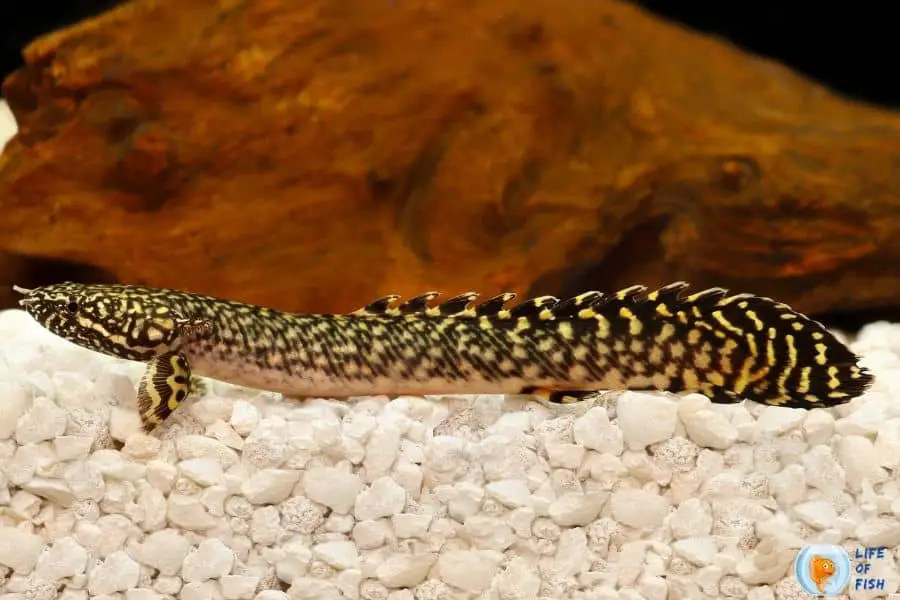
What Is Bichir?
Jump To
Bichir is totally different from other traditional freshwater fish, like their name. You know, all fish have their own appearance to grab the attraction of fish lovers. But actually, the appearance of Bichir is full of unique features. Almost all hobbyists try to add a vivid, colorful, or fancy look to their aquariums. So, these types of views are very common. But if you like to go beyond these common concepts, it is truly grateful.
Bichir gives a very prehistoric feeling to anyone who enjoys your aquarium. But do not misunderstand. Bichir also adds a colorful appearance to the tank. Actually, what is this Bichir? Bichir is living fossils that belong to the family Poypteridae. They are scientifically known as Polypterus bichri. This fish has about 60 million years of independent evaluation. So, it has a very ancient or prehistoric appearance. Plus, Bichir looks like a cross of a snake and eel. So, they are pretty long.
A Series of spiny dorsal fins situated at their backs is able to add value to this fish species, and these fins continue right into their tail. When it turns to the body of Bichir, it is quite scaly, and it supports and increases its reptilian look. These cover almost all the body areas except small patches situated on the underside of their heads. Their two large pectoral fins support highly for mobility when they are swimming. In addition to that, Bichir uses these fins to crawl around by pivoting these fins to be parallel with the substrate.
Further, tentacle-like extensions of their nose support them to smell and navigate in low-visibility water. Do you ever see Bichir before? Do your eyes catch the same appearance as them? If you are a Bichir lover, you may definitely discover Bichir with different colors and appearances. So, what are they?
Dinosaur Bichir
This is the most popular type of Bichir that you can find in the aquarium world. Mostly Dinosaur Bichir comes with a grey color, but this type is not large as other varieties. However, on the other hand, we can find out Dinosaur Bichir with light grey color and even pink and blue. Also, they bring you more ancient times through their pretty much classic Bichir mold.
Albino Bichir
If you want to rear a common Bichir with rare features, this Bichir type should be in your collection. Because their white body with red eyes surely enhances the beauty and uniqueness of your aquarium.
Saddled Bichir
This Bichir type is massive. They can grow up to about two and a half feet in length. Because of that, it is not wrong that we recognize Saddled Bichir as the largest type of Bichir. Saddled Bichir has a yellow color body. Plus, the black or dark grey stripes covering the body increase the attraction of the fish. Another different thing of this Bichir type is protruding lower jaw. It is not much prominent, but if you search clearly, it will be noticeable.
Ornate Bichir
This type is pretty large and has an attractive look. Ornate Bichir comes with a neat yellow base color body with black flecks that get closer together on their spiny dorsal fins. If you care for them well, you can own a two-foot-long fish. Moreover, Ornate Bichir loves to stay mainly at the bottom of the tank.
Delhezi Bichir
Generally, this type of Bichir comes in typical shape and size. So how do they differ from other Bichir types? Color patterns are the most exclusive trick that attracts the human eye to this fish type. Delhezi Bichir has a grey body with yellow flakes and green and short black stripes. So, another important thing is where you can find Bichir in the wild? Generally, Bichir lives across the freshwater environments in tropical Africa and the Nile river system. Plus, these fish love to live in estuaries and floodplains with muddy waters and silted substrates.
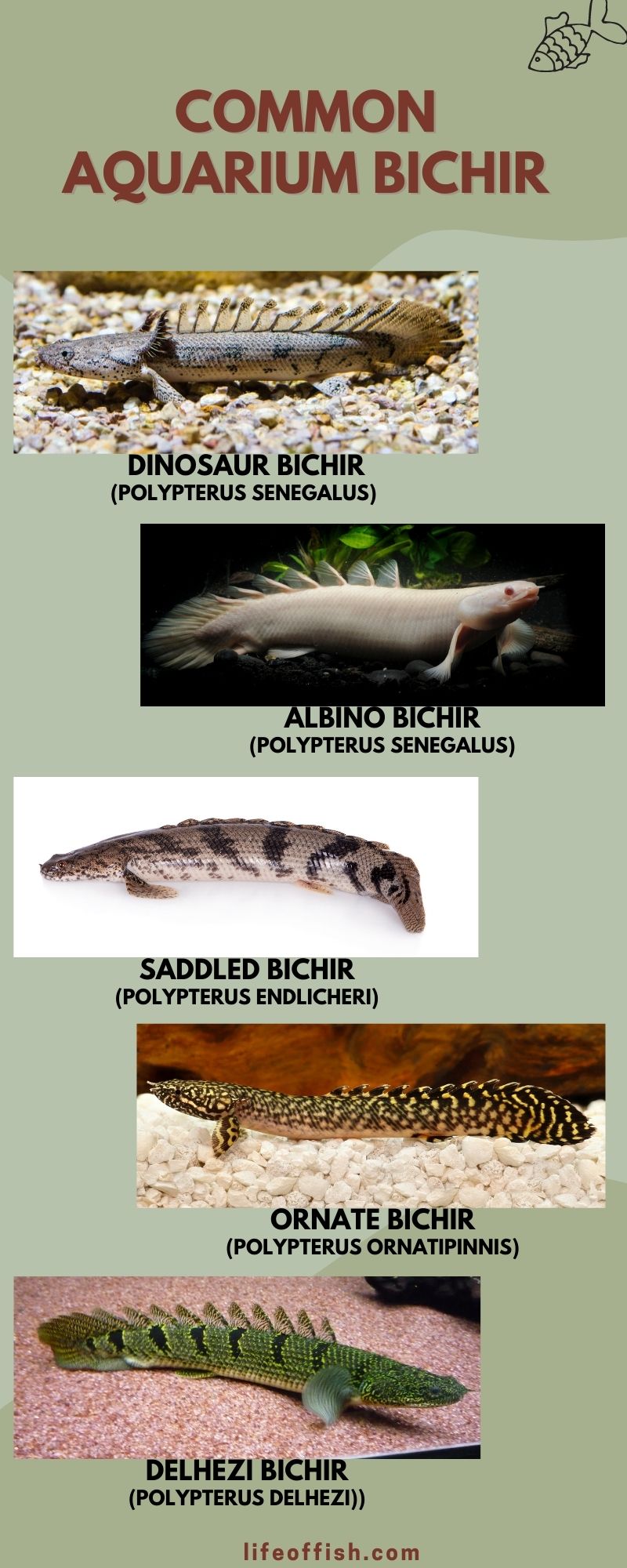
How does Big Bichir get?
As you know, there are several varieties of Bichir. So, the size may differ with variety. Therefore, we can identify the average size range of Bichir as 1 to 2.5 feet in length. So, firstly, you should clearly identify the variety of Bichir that you have. It is the main consideration of the fish size.
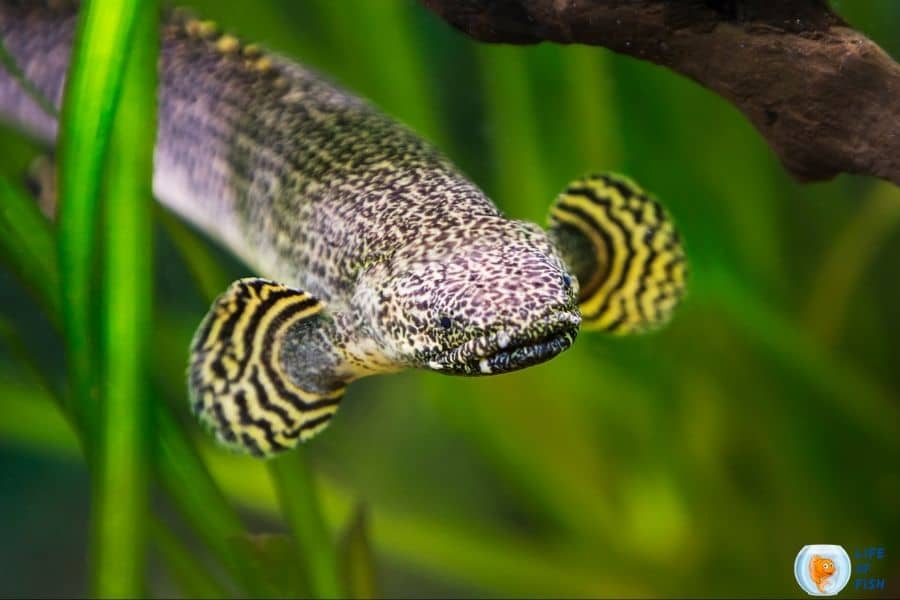
Is Bichir Aggressive?
Bichir can be recognized as a moderately aggressive fish species, so you should have to manage if they show some aggressive tendencies. Another important fact is this fish species is a predator. So, why did I say that Bichir is moderately aggressive? Mostly it is a problematic matter when keeping small fish species with Bichir. Because Bichir tends to nip their fins, it may happen until the small ones’ death.
In addition to these things, you know many fish species show pretty much aggressive behavior in mating season. So, this applies to Bichir the same. Male fish generally show aggressiveness towards female fish. Similarly, female fish show more aggression towards other tankmates when they are with eggs in their belly or trying to find some safe place to deposit the eggs.
Bichir Behavior
Bichir is pretty much active fish. As you know, their temperament is moderately aggressive. It means they are not very aggressive, but they may be aggressive. Bichirs are carnivores. Plus, they are predators. Because of these reasons, it can cause problems with other fish in the tank. So, where does Bichir love to stay?
They are bottom dwellers. But you can notice that Bichir regularly visits the tank’s surface. But why? Actually, Bichir is peculiar-looking fish that are able to breathe air. This fish has paired lungs that support gas exchange in poorly oxygenated environments. Also, Bichir has two small openings, namely spiracles on the top of the head. Fish breathe through them. So, they come to the surface to get a gulp of air. Because of this, the fish are always in motion. Consequently, they create an active aquarium.
Here I have an amazing secrete. Do you ever see a fish walk? If you observe your Bichirs clearly, you can notice that they are walking around the substrate. But wait! Am I correct? Can fish walk? Yes, Bichir can walk. But how? Bichir gets support from their pectoral fins and tail to move around. In addition to that, Bichir is active in the nighttime. So, they like to eat at night.
How Long Does Bichir Live?
Generally, this ancient time fish species, namely Bichir, can live around 15 to 20 years old in natural habitats. However, it is not a big challenge to keep 20 years in captivity if you care for them properly. The only thing is that you should maintain the water quality parameters and feed quality at an optimum level. However, the lifespan of the living organism will decide on the genetic factors too. So, you cannot control them. But if you are lucky and select a good gene strain, they will probably live around 20 years.
One Look Care Guide
| Scientific name | Polypterus bichri |
| Common name | Bichir |
| Care level | Intermediate |
| Native to | tropical Africa and the Nile river system |
| Type | Freshwater fish |
| Color | Species dependent |
| Tank size | 90 gallons per fish |
| Preferred temperature | 74 to 82 Fahrenheit |
| Other water parameters | pH level- 6.2 to 7.8 water hardness – KH 5 to 20 |
| Growth rate | No exact growth rate |
| Temperament | Moderately aggressive |
| Recommended tank mates | Flowerhorn cichlids Oscar fish African Knife Clown loaches Silver dollar fish Jack Dempsey fish Large barbs Large and medium catfish Blood parrots Other large and peaceful African cichlids |
| Preferred food | Bloodworms Shrimps Oxheart Weather loaches Nightcrawlers Small fish Pellets Flakes |
| Feeding frequency | 1 to 2 times per day |
| Breeding | Very difficult to breed in captivity |
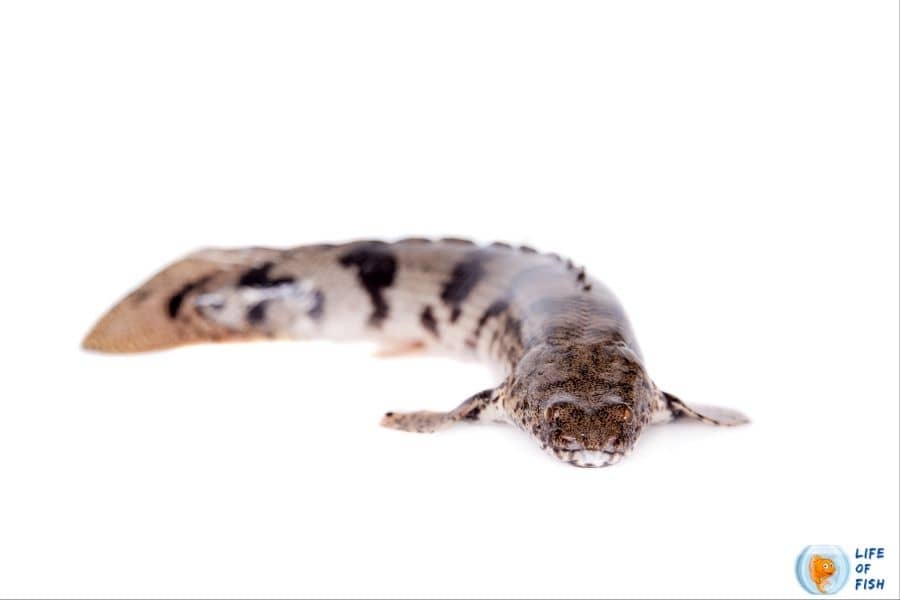
Bichir Care
Is caring and rearing a Bichir a challenge? Do not worry; it is not difficult and complex as you think. But you need some awareness of some factors related to Bichir. Sure, it will not be a big deal if you go through this guide.
Bichir tank size
If you wish to rear Bichir, you should have at least 90 gallons of tank per fish. What do you think? How much space do they need? Before the answer, first, consider the size and activity level of Bichir. Now you can understand that this fish species needs ample room. Therefore, if you want to keep your fish comfortably, provide adequate space to swim them freely. However, some hobbyists try to rear their Bichir in the 40 gallons tank. But we do not recommend it because it will not be home but jail for your fish. So, keep in mind that as a fish owner, whatever fish you rear, it is your responsibility to care for your fish well by providing optimal habitat for them to live happily and healthily.
How many Bichir should be kept together?
No worries, you have the ability to rear multiple Bichirs together. But you should need space. Generally, Bichir will often form ‘poly piles. Plus, they are quite sociable fish species. So, here what you need is only space, and the selected Bichirs are a similar size. Plus, if you keep several Bichirs, it is better to have a large tank that is 100 gallons or greater. Because If your tank is overcrowded or too small, Bichir will be aggressive and territorial, especially towards others of their kind. So, almost all the time, it is preferable to rear a single Bichir or mated pair at any given time because it won’t make trouble.
Tank Setup
When you set up an aquarium for any fish species, the common rule is that you should mimic their natural environment. So, let’s see how we set up the Bichir tank. The fun factor is that the Bichir does nicely with a variety of habitat decorations. So, what can you add to your Bichir tank? As usual, give some space to driftwoods or caves and plants from the tank. However, keeping Bichir in a more sparse tank is not a challenge because these fish species are not picky. Anyhow, it is a must to leave space above the water because Bichir comes to the surface to breathe.
Another important thing is the substrate. Here you should select the right substrate. It is highly recommended to go with a sandy substrate. But why? Actually, a sandy substrate is more comfortable and safer for your Bichir because we should remember that they are bottom dwellers. But why can’t we go with gravels alternative to sand? Think, what is the comfortable substrate, sand or gravel? You know gravel can be too rough on their bellies. Plus, there are reported cases in which they eat gravel accidentally when scavenging for food.
In addition to that, as usual, it is important to have a good filter system. It plays the main role in eliminating the toxic chemicals generated from leftover foods. As Bichir’s owner, I suggest putting a tight cover or lid on your tank. It has a possibility to jump out or crawl out of them.
Water Quality Condition
Bichir is pretty hard. It is good news for hobbyists who are not experts. Because Bichir can survive in a wide range of water parameters, you should maintain the water parameters below level.
Water temperature: It is vital to keep the water temperature at 74 to 82 Fahrenheit.
pH level: You should maintain the pH level at 6.2 to 7.8.
Water hardness: They love to live in soft water
KH: It is better to keep the KH at 5-20 in your tank
In addition to this, it is important to monitor the water quality with a test kit and perform water changes regular basis. Keeping the water conditions at the ideal level helps Bichirs to live alone.
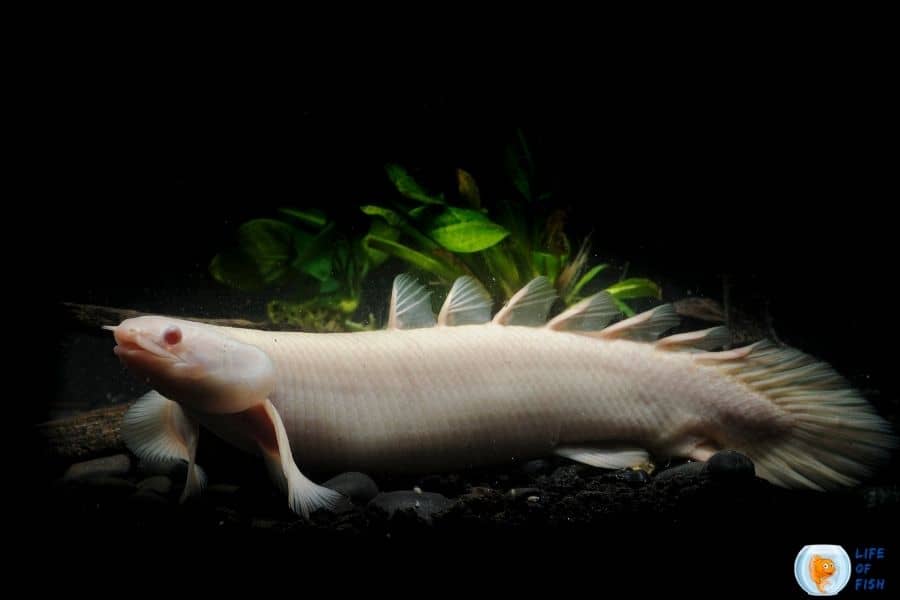
Bichir Breeding
Generally, the common belief is that breeding in captivity is quite difficult. But do not lose hope. Keep reading!
Male Or Female Identification
If you need to clarify whether your Bichir is male or female, you have to check several things. So, what are they? Let’s start with anal fins. Male has anal fin; it is thicker and wide than female fish. Then you can check the dorsal fin of both fish to understand the gender difference clearly. It is broader on male than female fish. Another tip is that adult female grows faster and larger than male. However, you just need to look at your aquarium to identify the gender in the breeding season.
But how do you do it this much easier? Because in the breeding season, male fish tends to chase the female fish. In addition to this, keep in mind that immature fish look identical. Because of that, when they are young, it is very difficult to separate them as female and male. But when they gradually grow and reach sexual maturity, the above differences are clearly noticeable.
Bichir Breeding
Actually, there are no significant amount of reported cases and information about how to breed Bichir in captivity because it is difficult successfully. As you know, there are several types of Bichir in the aquarium world. So, they need slightly different water and tank conditions to breed. However, these conditions are not yet understood perfectly. So, if you wish to breed your Bichirs, firstly, you should have to experiment more and more. Because first, you need clear awareness. However, when it turns to currently available information, you can find more information about Senegal or grey Bichir breeding. Because comparatively, it is easy.
So how do you know your Bichir is ready to mate? The familiar reaction is that the male fish chase the female fish. Also, the male may nudge or bump into her with his snout, and this behavior may be continued within a day or two days. After spawning, female fish lay their eggs in a safe place. They probably lay eggs among plants or sheltered areas in the tank. However, after the fertilizing process, removing the parent fish from the tank is necessary because they will eat eggs.
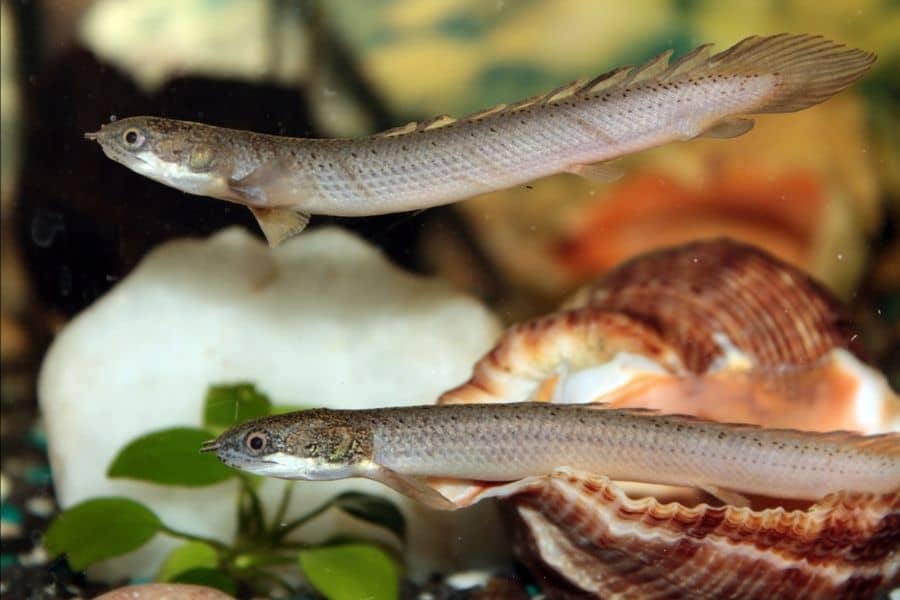
How To Improve The Chance Of Successful Breed
You know, it is difficult to breed Bichir in captivity. But you can increase the chances. So, how do you do it?
- It is better to add extra plants or spawning mops to the tank. Because thick, lush greenery will provide the best covering safe spot for females to lay eggs
- You can keep a slightly warmer water temperature because it induces the breeding behavior of the fish. Here you can keep around 82 Fahrenheits as a signal that it is time to breed.
- Also, they are active at night, even though the breeding season. So, this nocturnal fish species prefers to breed at night. Therefore, reducing the light from 8 to 6 hours is better. If not, it is recommended to use blue light.
- It is recommended to provide a varied and high-quality balanced diet of meaty, live foods. Because it will boost them to breed, also, you can give little extra food more often to trigger spawning behaviors.
How Many Babies Do they Have?
Generally, a female lays 100 to 300 eggs in a single spawning event. However, this amount can be varied with the health level and age of the fish. So, when selecting a breeding pair, go for a well grow fish. Because their body size directly impacts the babies’ amount. The larger one can produce more babies than smaller Bichirs.
Fry Care
You can feed their babies with the most common foods like brine shrimps and micro worms because these foods contain a high amount of proteins. So, rich proteins help to boost fry growth and immunity. Moreover, it has the ability to protect more babies at the early stages.
Feeding behavior
They are carnivores. So, you have only to provide meaty foods. The most important thing is to ensure your fish gets enough protein-rich foods unless your fish cannot live healthily and actively.
What Do They Eat in the wild?
Naturally, they are predators. So they eat small vertebrates, crustaceans, insects, and other small fish.
What Do They Eat in Captivity?
You should feed them with protein-rich dry, live, and frozen foods. In addition to that, you can go with sinking flakes and pellets as supplements. So, try out the below foods.
- Bloodworms
- Shrimps
- Oxheart
- Weather loaches
- Nightcrawlers
- Small fish
- Pellets
- Flakes
How Often Should You Feed
It is better to feed them 1 to 2 times per day.
When Should You Feed your Bichirs
They are nocturnal. So, they like to feed at night. Therefore, you should feed them at night and early in the morning. Always try to feed them these times. Anyhow if you cannot feed them at that time, switch off the lights and feed your fish.
How Long they Can Go Without Food
Generally, fish can go for around 7 days without food. But this will depend on the health and the age of the particular fish.
What fish can live with Bichir?
When you select tankmates for your Bichir, you should highly consider their temperament. Yes, Ther are semi-aggressive, so they are potentially aggressive. Also, it is a must to consider the size of the tankmates. Because they are carnivores and they tend to eat small fish. So, here are some recommendations to keep with them.
- Flowerhorn cichlids
- Oscar fish
- African knife
- Clown loaches
- Silver dollar fish
- Jack Dempsey fish
- Large barbs
- Large and medium catfish
- Blood parrots
- Other large and peaceful African cichlids
Read Next : 12 Fish That Looks Like A Dragon (Oh Yes! I Am Not Kidding)
